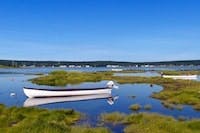The U.S. Environmental Protection Agency (EPA) and U.S. Army Corps of Engineers jointly released a proposed rule to clarify protection under the Clean Water Act for streams and wetlands that form the foundation of the nation’s water resources. The proposed rule will benefit businesses by increasing efficiency in determining coverage of the Clean Water Act. The agencies are launching an outreach effort over the next 90 days, holding discussions around the country and gathering input needed to shape a final rule.
Determining Clean Water Act protection for streams and wetlands became confusing and complex following Supreme Court decisions in 2001 and 2006. For nearly a decade, members of Congress, state and local officials, industry, agriculture, environmental groups and the public asked for a rulemaking to provide clarity.
The proposed rule clarifies protection for streams and wetlands. The proposed definitions of waters will apply to all Clean Water Act programs. It does not protect any new types of waters that have not historically been covered under the Clean Water Act and is consistent with the Supreme Court’s more narrow reading of Clean Water Act jurisdiction.
“We are clarifying protection for the upstream waters that are absolutely vital to downstream communities,” said EPA Administrator Gina McCarthy. “Clean water is essential to every single American, from families who rely on safe places to swim and healthy fish to eat, to farmers who need abundant and reliable sources of water to grow their crops, to hunters and fishermen who depend on healthy waters for recreation and their work, and to businesses that need a steady supply of water for operations.”
Specifically, the proposed rule clarifies that under the Clean Water Act and based on the science:
- • Most seasonal and rain dependent streams are protected.
- • Wetlands near rivers and streams are protected.
- • Other types of waters may have more uncertain connections with downstream water and protection will be evaluated through a case specific analysis of whether the connection is or is not protecting similarly situated waters in certain geographic areas or adding to the categories of waters protected without case specific analysis.
The proposed rule preserves the Clean Water Act exemptions and exclusions for agriculture. Additionally, EPA and the Army Corps have coordinated with the U.S. Department of Agriculture (USDA) to develop an interpretive rule to ensure that 53 specific conservation practices that protect or improve water quality will not be subject to Section 404 dredged or fill permitting requirements. The agencies will work together to implement these new exemptions and periodically review, and update USDA’s Natural Resources Conservation Service conservation practice standards and activities that would qualify under the exemption. Any agriculture activity that does not result in the discharge of a pollutant to waters of the U.S. still does not require a permit.
The proposed rule also helps states and tribes—according to a study by the Environmental Law Institute, 36 states have legal limitations on their ability to fully protect waters that aren’t covered by the Clean Water Act.
The proposed rule is supported by the latest peer-reviewed science, including a draft scientific assessment by EPA, which presents a review and synthesis of more than 1,000 pieces of scientific literature. The rule will not be finalized until the final version of this scientific assessment is complete.
Forty years ago, two-thirds of America’s lakes, rivers and coastal waters were unsafe for fishing and swimming. Because of the Clean Water Act, that number has been cut in half. However, one-third of the nation’s waters still do not meet standards.
The proposed rule will be open for public comment for 90 days from publication in the Federal Register. The interpretive rule for agricultural activities is effective immediately.
Source: EPA


